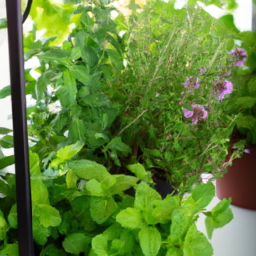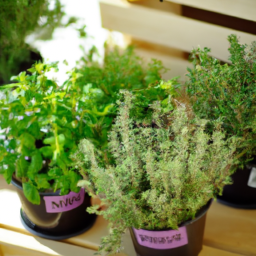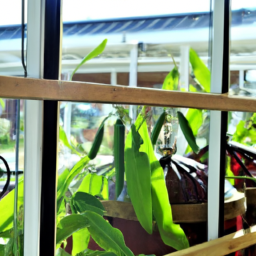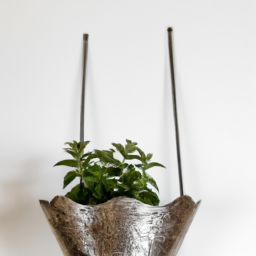
Are you tired of constantly buying expensive herbs from the grocery store, only to have them wilt and go to waste before you can use them all? Well, we have the perfect solution for you: a container herb garden! With a container herb garden, you can have fresh flavors at your fingertips, whenever you need them. Whether you have a spacious backyard or a tiny balcony, this blog post will guide you on how to create your very own container herb garden and enjoy the convenience of having a variety of herbs just a few steps away from your kitchen. So, let’s dive in and discover the joy of cultivating a container herb garden that will elevate your cooking and bring a burst of freshness to your meals!
Benefits of Container Herb Gardens: Exploring the advantages of growing herbs in containers
Introduction
Container herb gardens have gained popularity in recent years as more people are embracing the joys of growing their own fresh herbs. Whether you have limited outdoor space or simply want to have easy access to aromatic and flavorful herbs, a container herb garden is the perfect solution. In this guide, we will explore the numerous benefits of container herb gardens and provide you with a step-by-step guide to create your own flavorful oasis.
1. Flexibility and Convenience
One of the key advantages of container herb gardens is their flexibility and convenience. Unlike traditional gardens, container herb gardens can be placed anywhere, from balconies and patios to windowsills and kitchen counters. This means you can have fresh herbs right at your fingertips, no matter the size of your living space. Additionally, containers can be easily moved around to optimize sunlight exposure or protect delicate herbs from harsh weather conditions.
Furthermore, container herb gardens allow you to control the growing environment. You can choose the ideal soil type and composition, ensuring your herbs receive the necessary nutrients for healthy growth. This flexibility also extends to the choice of herbs you can grow. Whether you prefer culinary herbs like basil, thyme, and rosemary, or medicinal herbs like chamomile and lavender, you can create a diverse herb garden tailored to your specific needs and preferences.
Lastly, container herb gardens eliminate the need for extensive weeding and maintenance. With a contained space, the growth of unwanted plants is significantly reduced, saving you time and effort in maintaining your garden.
2. Extend the Growing Season
Another advantage of container herb gardens is the ability to extend the growing season. In colder climates, herbs planted in containers can be brought indoors during the winter months, allowing you to enjoy fresh herbs year-round. By placing your containers near a sunny window or using grow lights, you can provide the necessary light and warmth for your herbs to thrive even in the coldest months.
Moreover, container herb gardens offer protection against pests and diseases. By keeping your herbs off the ground, you minimize the risk of soil-borne diseases and pests that can damage your plants. This means your herbs are less likely to be affected by common garden problems, ensuring a healthier and more abundant harvest.
Additionally, container herb gardens are less susceptible to extreme weather conditions. During heatwaves or heavy rains, you can easily move your containers to a safer location, preventing damage to your precious herbs. This adaptability allows you to maintain a thriving herb garden regardless of the unpredictable weather patterns.
3. Aesthetically Pleasing and Space-Saving
Container herb gardens not only provide fresh flavors but also enhance the visual appeal of your living space. With an array of container options available, from traditional clay pots to modern hanging baskets and vertical planters, you can create a visually stunning herb garden that complements your style and decor.
Furthermore, container herb gardens are an excellent solution for those with limited space. Whether you live in an apartment or have a small backyard, you can still enjoy the benefits of herb gardening. Vertical planters and hanging baskets utilize vertical space, while window boxes and tiered containers maximize the use of limited horizontal space. By utilizing these space-saving techniques, you can transform even the smallest area into a vibrant and productive herb garden.
Moreover, container herb gardens offer the opportunity for creative and unique designs. You can mix and match different herbs in a single container, creating a visually appealing and aromatic centerpiece. Additionally, you can experiment with various container materials, colors, and textures to add a personalized touch to your herb garden.
Conclusion
Container herb gardens offer numerous benefits that make them an attractive option for herb enthusiasts and beginners alike. Their flexibility, convenience, and ability to extend the growing season make them a practical choice for any living space. Furthermore, container herb gardens provide an aesthetic appeal and space-saving solutions, allowing you to enjoy the beauty and flavors of fresh herbs, even in limited areas. So why not embark on your own container herb garden journey and experience the joys of having fresh flavors at your fingertips?

Essential Herbs for a Container Herb Garden: Discovering the Must-Have Herbs for a Thriving Garden
Welcome to the wonderful world of container herb gardening! Whether you have limited space, want to add fresh flavors to your cooking, or simply enjoy the beauty and fragrance of herbs, creating a container herb garden is a fantastic choice. In this guide, we will explore the essential herbs that are perfect for a thriving container garden.
1. Basil
Basil is a versatile herb that should be at the top of your list. Its vibrant green leaves and distinct aroma make it a popular choice for both culinary and medicinal purposes. Basil thrives in containers, and you can choose from various varieties such as sweet basil, lemon basil, or Thai basil. It requires well-drained soil, ample sunlight, and regular watering to flourish.
In the kitchen, basil adds a refreshing touch to salads, pasta dishes, and even cocktails. It pairs exceptionally well with tomatoes, making it a staple in Italian cuisine. You can also use basil leaves to make a soothing tea that aids digestion and reduces stress.
To grow basil, sow the seeds directly into the container or transplant young seedlings. Keep the soil moist and pinch off the flowers to encourage leaf growth. With proper care, your basil will provide you with a bountiful harvest throughout the growing season.
2. Rosemary
Rosemary is an evergreen herb that adds a delightful fragrance to any container garden. Its needle-like leaves and woody stems make it an attractive addition to both outdoor and indoor spaces. Rosemary prefers well-drained soil and full sun, making it an excellent choice for container gardening.
In the culinary world, rosemary is a staple herb used in a variety of dishes. Its robust flavor complements roasted meats, potatoes, and vegetables. You can also infuse olive oil with rosemary for a fragrant and flavorful dressing.
To grow rosemary, start with a small plant or propagate it from cuttings. Ensure the container has good drainage and provide regular watering, allowing the soil to dry out slightly between waterings. Prune the plant regularly to maintain its shape and encourage new growth.
3. Mint
Mint is a refreshing herb that is incredibly easy to grow in containers. Its fast growth and spreading nature make it a great choice for beginners. Mint varieties like spearmint and peppermint are perfect for teas, cocktails, and desserts.
When planting mint, choose a container with ample drainage holes to prevent waterlogging. Mint thrives in partial shade, but it can tolerate full sun as well. Keep the soil consistently moist, and be prepared to trim back the plant regularly to prevent it from taking over your garden.
Aside from its culinary uses, mint also has medicinal properties. It aids digestion, relieves headaches, and even repels insects. With mint in your container herb garden, you’ll have a versatile herb at your fingertips.
Now that you have discovered the essential herbs for a thriving container herb garden, it’s time to get your hands dirty and start planting. Remember to choose high-quality soil, provide adequate sunlight, and water your herbs regularly. With a little love and care, your container herb garden will reward you with fresh flavors and aromatic delights throughout the year.

Container Herb Garden: Fresh Flavors at Your Fingertips
Introduction
Welcome to the wonderful world of container herb gardening! Growing your own herbs in containers is a fantastic way to add fresh flavors to your culinary creations while also beautifying your outdoor space. Whether you have a large backyard or a tiny balcony, a container herb garden can fit seamlessly into any space. In this guide, we will provide you with expert advice on how to maintain your container herb garden and ensure a bountiful harvest. So, let’s dig in!
Choosing the Right Containers
When it comes to container herb gardening, choosing the right containers is crucial. The size, material, and drainage of the containers can greatly impact the health and growth of your herbs. Here are some tips to help you make the right choice:
- Size: Select containers that are at least 6-8 inches deep to allow ample space for root development. Herbs like basil and mint require larger containers, while smaller herbs like thyme and oregano can thrive in smaller pots.
- Material: Opt for containers made of breathable materials like terracotta or wood, as they allow for better airflow and drainage. Avoid plastic containers that can retain excess moisture and lead to root rot.
- Drainage: Ensure that your containers have drainage holes at the bottom to prevent waterlogging. If your chosen container lacks drainage holes, you can create them using a drill or add a layer of gravel at the bottom to improve drainage.
Remember, each herb may have specific container requirements, so it’s essential to research their individual needs before planting.
Choosing the Right Soil
The soil you use for your container herb garden plays a vital role in providing the necessary nutrients and moisture for healthy herb growth. Here’s what you need to know:
- Quality: Opt for high-quality potting soil that is well-draining and rich in organic matter. Avoid using garden soil, as it can be heavy and may not provide adequate drainage.
- Moisture Retention: Look for potting soil that retains moisture without becoming waterlogged. Herbs prefer slightly moist soil, so ensure that the soil doesn’t dry out completely between watering.
- Fertilization: Consider adding slow-release organic fertilizer to the soil before planting your herbs. This will provide a steady supply of nutrients throughout the growing season.
Remember to regularly monitor the moisture levels in the soil and adjust your watering schedule accordingly.
Caring for Your Container Herb Garden
Proper care is essential for maintaining a thriving container herb garden. Here are some expert tips to help you keep your herbs healthy and productive:
1. Watering
Watering is one of the most critical aspects of herb garden maintenance. Here’s what you need to keep in mind:
- Consistency: Herbs generally prefer slightly moist soil, so aim to water them when the top inch of soil feels dry to the touch. Avoid overwatering, as it can lead to root rot.
- Watering Technique: Water your herbs at the base of the plants rather than overhead to prevent wetting the foliage excessively. This helps reduce the risk of fungal diseases.
- Early Morning Watering: Water your herbs in the early morning to allow any excess moisture on the leaves to dry off during the day, reducing the chances of disease.
2. Sunlight
Most herbs thrive in full sun, so it’s crucial to provide them with adequate sunlight. Here’s what you need to know:
- Sun Exposure: Place your containers in a location that receives at least 6-8 hours of direct sunlight each day. South-facing balconies or windowsills are ideal for maximizing sunlight exposure.
- Shade Considerations: While herbs love sunlight, some may benefit from partial shade during the hottest part of the day, especially in regions with scorching summers. Experiment with different locations to find the perfect balance of sun and shade for your herbs.
3. Pruning and Harvesting
Pruning and harvesting your herbs not only keeps them in shape but also encourages bushier growth and prolongs their productivity. Follow these guidelines:
- Regular Pruning: Pinch or trim your herbs regularly to promote branching and prevent them from becoming too leggy. This also encourages the growth of fresh leaves for you to enjoy in your culinary endeavors.
- Harvesting Tips: Harvest your herbs frequently by snipping off the outer leaves or stems. This will stimulate new growth and ensure a continuous supply of fresh herbs throughout the season.
- End-of-Season Pruning: Before winter sets in, give your herbs a final pruning to remove any dead or diseased foliage. This helps prepare them for the dormant period and ensures healthier regrowth in the following season.
By following these care tips, you’ll be well on your way to maintaining a flourishing container herb garden that provides you with fresh flavors all year round!
Conclusion
A container herb garden is a delightful addition to any home, providing you with fresh flavors at your fingertips. By selecting the right containers, soil, and providing proper care, you can enjoy a bountiful harvest of your favorite herbs. Remember to choose containers that allow for adequate drainage, use high-quality potting soil, and water your herbs consistently. Additionally, ensure your herbs receive ample sunlight and regularly prune and harvest to encourage healthy growth. With these expert tips, your container herb garden will thrive, bringing joy and flavor to your culinary adventures. Happy gardening!
Highlights of this article
If you love cooking with fresh herbs but don’t have the space for a traditional garden, a container herb garden might be the perfect solution for you. With a container herb garden, you can enjoy the vibrant flavors of fresh herbs right at your fingertips, even if you live in a small apartment or have limited outdoor space.
Container herb gardens are not only practical but also aesthetically pleasing. You can choose from a wide variety of containers to match your personal style and complement your existing decor. Whether it’s a set of colorful pots on your windowsill or a hanging basket on your balcony, a container herb garden adds a touch of greenery and freshness to any space.
The beauty of a container herb garden lies in its versatility. You can grow a wide range of herbs, from basil and parsley to rosemary and thyme, all in one compact area. Not only will you have a constant supply of fresh herbs for your culinary adventures, but you’ll also enjoy the convenience of having them readily available whenever you need them. No more last-minute trips to the grocery store or settling for dried herbs – with a container herb garden, you’ll always have the freshest flavors right at your fingertips.
Creating a container herb garden is simple and requires minimal effort. All you need is a sunny spot, some quality potting soil, and your choice of herb plants or seeds. Whether you’re a seasoned gardener or a beginner, container herb gardens are a great way to get started with gardening and enjoy the satisfaction of growing your own food. So why not give it a try and embark on a journey of fresh flavors and culinary delights with your very own container herb garden?
FAQ Roundup:
Q1: What is a container herb garden?
A1: A container herb garden is a small-scale garden that allows you to grow herbs in containers, such as pots or planters, instead of in traditional garden beds. It provides a convenient and accessible way to grow fresh herbs right at your fingertips, even if you have limited space.
Q2: What are the benefits of having a container herb garden?
A2: Having a container herb garden offers several benefits. Firstly, it allows you to enjoy the convenience of having fresh herbs readily available for cooking or garnishing dishes. It also saves space, making it perfect for urban dwellers or those with limited outdoor areas. Additionally, container herb gardens are portable, meaning you can easily move them around to optimize sunlight exposure or protect the herbs from harsh weather conditions.
Q3: Which herbs are suitable for a container herb garden?
A3: Many herbs thrive in container gardens. Some popular options include basil, parsley, mint, rosemary, thyme, chives, and cilantro. These herbs are generally well-suited for container growth due to their compact size and adaptability to different growing conditions. However, it’s important to consider the specific needs of each herb, such as sunlight requirements and watering preferences, to ensure successful growth.
Q4: How do I start a container herb garden?
A4: Starting a container herb garden is relatively simple. Begin by selecting suitable containers with drainage holes to prevent waterlogging. Fill the containers with well-draining potting soil and plant your chosen herbs, ensuring they have enough space to grow. Place the containers in a location that receives adequate sunlight, typically 6-8 hours per day. Regularly water the herbs, allowing the soil to dry slightly between waterings. Lastly, provide occasional fertilization to promote healthy growth.
Q5: Are there any tips for maintaining a container herb garden?
A5: Absolutely! To maintain a thriving container herb garden, it’s important to monitor the moisture level of the soil and water accordingly. Overwatering can lead to root rot, while underwatering can cause the herbs to wither. Additionally, regularly check for pests and diseases, as container gardens are not immune to these issues. Pruning or harvesting herbs regularly promotes bushier growth and prevents them from becoming leggy. Finally, consider providing some shade during scorching summer days to prevent wilting or sunburn on delicate herbs.

Lisa Chen is a seasoned indoor gardening expert and the author of several bestselling books on the topic. With a background in horticulture and urban farming, Lisa is dedicated to helping urban dwellers embrace the joys of cultivating green spaces indoors. Her detailed guides and hands-on tips empower readers to transform their living spaces into thriving plant sanctuaries.


